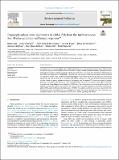Por favor, use este identificador para citar o enlazar a este item:
http://hdl.handle.net/10261/253101COMPARTIR / EXPORTAR:
 SHARE SHARE
 CORE
BASE CORE
BASE
|
|
| Visualizar otros formatos: MARC | Dublin Core | RDF | ORE | MODS | METS | DIDL | DATACITE | |

| Título: | Organophosphate ester plasticizers in edible fish from the Mediterranean Sea: Marine pollution and human exposure |
Autor: | Sala, Berta CSIC ORCID; Giménez, Joan CSIC ORCID ; Fernández-Arribas, Julio CSIC ORCID; Bravo, Carlota; Lloret Lloret, Elena CSIC ORCID ; Esteban-Acón, Antonio; Bellido, José M.; Coll, Marta CSIC ORCID ; Eljarrat, Ethel CSIC ORCID | Palabras clave: | Bioaccumulation Biomagnification Human health Marine biota Organophosphorus flame retardants |
Fecha de publicación: | ene-2022 | Editor: | Elsevier | Citación: | Environmental Pollution 292(PartB): 118377 (2022) | Resumen: | Concentrations of organophosphate esters (OPEs) plasticizers were analysed in the present study. Fifty-five fish samples belonging to three highly commercial species, European sardine (Sardina pilchardus), European anchovy (Engraulis encrasicolus), and European hake (Merluccius merluccius), were taken from the Western Mediterranean Sea. OPEs were detected in all individuals, except for two hake samples, with concentrations between 0.38 and 73.4 ng/g wet weight (ww). Sardines presented the highest mean value with 20.5 ± 20.1 ng/g ww, followed by anchovies with 14.1 ± 8.91 ng/g ww and hake with 2.48 ± 1.76 ng/g ww. The lowest OPE concentrations found in hake, which is a partial predator of anchovy and sardine, and the higher δ15N values (as a proxy of trophic position), may indicate the absence of OPEs biomagnification. Eleven out of thirteen tested OPEs compounds were detected, being diphenyl cresyl phosphate (DCP) one of the most frequently detected in all the species. The highest concentration values were obtained for tris(1,3-dichloro-2-propyl) phosphate (TDClPP), trihexyl phosphate (THP), and tris(2-butoxyethyl) phosphate (TBOEP), for sardines, anchovies, and hakes, respectively. The human health risk associated with the consumption of these fish species showing that their individual consumption would not pose a considerable threat to public health regarding OPE intake | Descripción: | 10 pages, 4 figures, 2 tables, supplementary data https://doi.org/10.1016/j.envpol.2021.118377 | Versión del editor: | https://doi.org/10.1016/j.envpol.2021.118377 | URI: | http://hdl.handle.net/10261/253101 | DOI: | 10.1016/j.envpol.2021.118377 | ISSN: | 0269-7491 | E-ISSN: | 1873-6424 |
| Aparece en las colecciones: | (ICM) Artículos (ICMAN) Artículos (IDAEA) Artículos |
Ficheros en este ítem:
| Fichero | Descripción | Tamaño | Formato | |
|---|---|---|---|---|
| Sala_et_al_2022.pdf | 1,79 MB | Adobe PDF |  Visualizar/Abrir | |
| Sala_et_al_2022_suppl.docx | 199,97 kB | Microsoft Word XML | Visualizar/Abrir |
CORE Recommender
SCOPUSTM
Citations
32
checked on 13-abr-2024
WEB OF SCIENCETM
Citations
25
checked on 29-feb-2024
Page view(s)
103
checked on 22-abr-2024
Download(s)
102
checked on 22-abr-2024
Google ScholarTM
Check
Altmetric
Altmetric
Este item está licenciado bajo una Licencia Creative Commons



